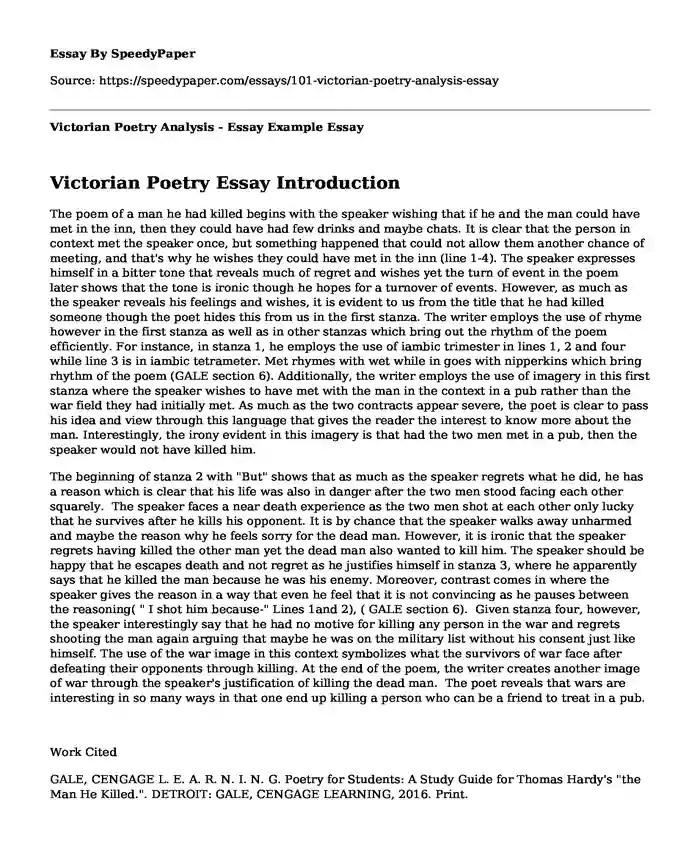Victorian Poetry Essay Introduction
The poem of a man he had killed begins with the speaker wishing that if he and the man could have met in the inn, then they could have had few drinks and maybe chats. It is clear that the person in context met the speaker once, but something happened that could not allow them another chance of meeting, and that's why he wishes they could have met in the inn (line 1-4). The speaker expresses himself in a bitter tone that reveals much of regret and wishes yet the turn of event in the poem later shows that the tone is ironic though he hopes for a turnover of events. However, as much as the speaker reveals his feelings and wishes, it is evident to us from the title that he had killed someone though the poet hides this from us in the first stanza. The writer employs the use of rhyme however in the first stanza as well as in other stanzas which bring out the rhythm of the poem efficiently. For instance, in stanza 1, he employs the use of iambic trimester in lines 1, 2 and four while line 3 is in iambic tetrameter. Met rhymes with wet while in goes with nipperkins which bring rhythm of the poem (GALE section 6). Additionally, the writer employs the use of imagery in this first stanza where the speaker wishes to have met with the man in the context in a pub rather than the war field they had initially met. As much as the two contracts appear severe, the poet is clear to pass his idea and view through this language that gives the reader the interest to know more about the man. Interestingly, the irony evident in this imagery is that had the two men met in a pub, then the speaker would not have killed him.
The beginning of stanza 2 with "But" shows that as much as the speaker regrets what he did, he has a reason which is clear that his life was also in danger after the two men stood facing each other squarely. The speaker faces a near death experience as the two men shot at each other only lucky that he survives after he kills his opponent. It is by chance that the speaker walks away unharmed and maybe the reason why he feels sorry for the dead man. However, it is ironic that the speaker regrets having killed the other man yet the dead man also wanted to kill him. The speaker should be happy that he escapes death and not regret as he justifies himself in stanza 3, where he apparently says that he killed the man because he was his enemy. Moreover, contrast comes in where the speaker gives the reason in a way that even he feel that it is not convincing as he pauses between the reasoning( " I shot him because-" Lines 1and 2), ( GALE section 6). Given stanza four, however, the speaker interestingly say that he had no motive for killing any person in the war and regrets shooting the man again arguing that maybe he was on the military list without his consent just like himself. The use of the war image in this context symbolizes what the survivors of war face after defeating their opponents through killing. At the end of the poem, the writer creates another image of war through the speaker's justification of killing the dead man. The poet reveals that wars are interesting in so many ways in that one end up killing a person who can be a friend to treat in a pub.
Work Cited
GALE, CENGAGE L. E. A. R. N. I. N. G. Poetry for Students: A Study Guide for Thomas Hardy's "the Man He Killed.". DETROIT: GALE, CENGAGE LEARNING, 2016. Print.
Cite this page
Victorian Poetry Analysis - Essay Example. (2018, Jul 02). Retrieved from https://speedypaper.com/essays/101-victorian-poetry-analysis-essay
Request Removal
If you are the original author of this essay and no longer wish to have it published on the SpeedyPaper website, please click below to request its removal:
- Essay Sample: Jane Eyre as a Student vs. Jane Eyre as a Teacher/Governess
- Symbolism in The Merchant of Venice: Essay Sample for You
- Essay Sample: Sources of Information for a Business
- Organizational Change in Shell Oil Company, Free Essay in Management
- Essay Example: Barack Obama Character Sketch
- Younger African Writers Have a Louder Voice but Less Power. Essay Example
- Paper Example. Importance of Originality
Popular categories





